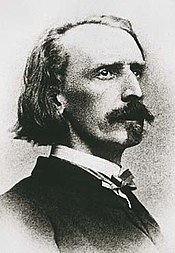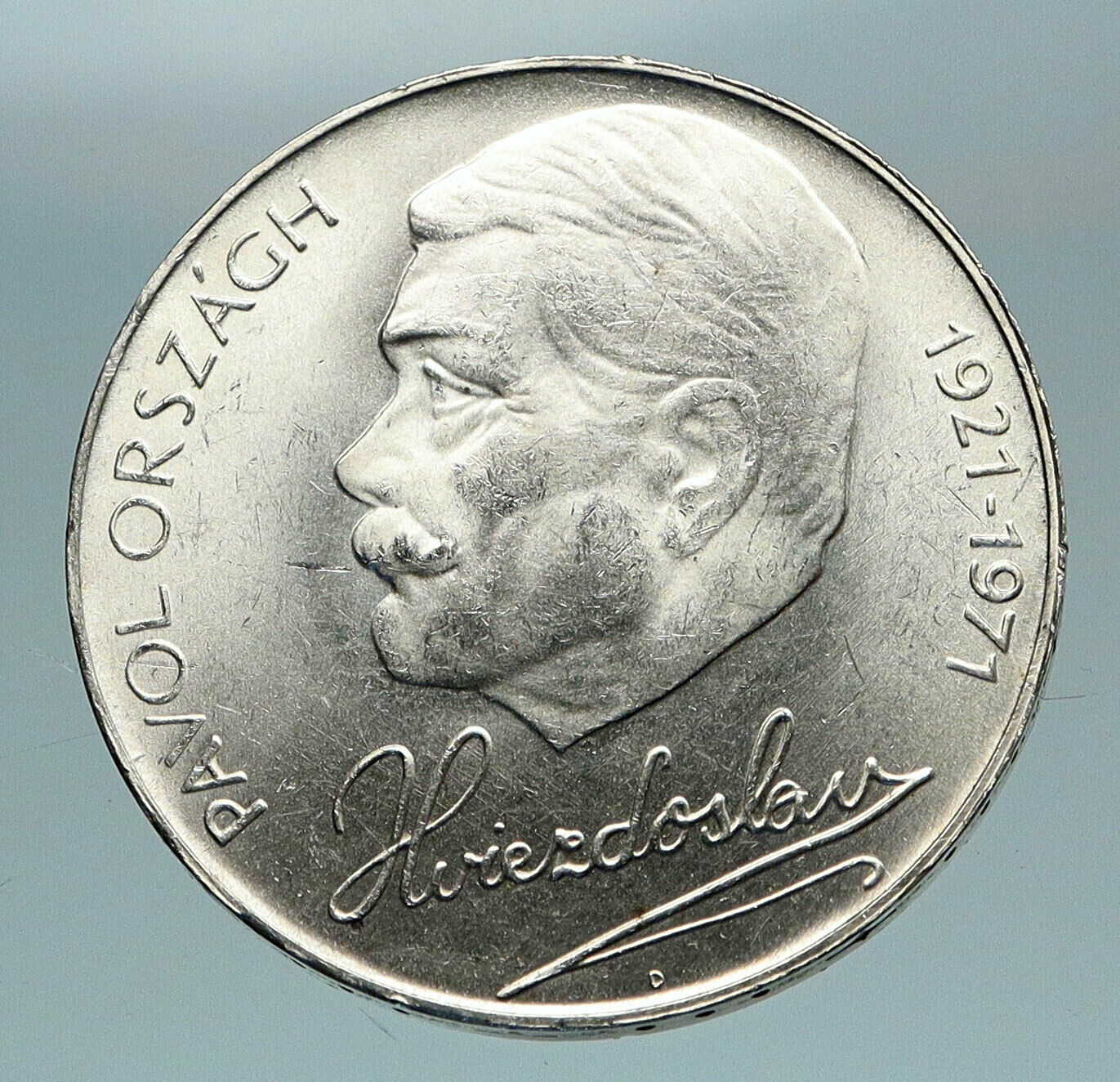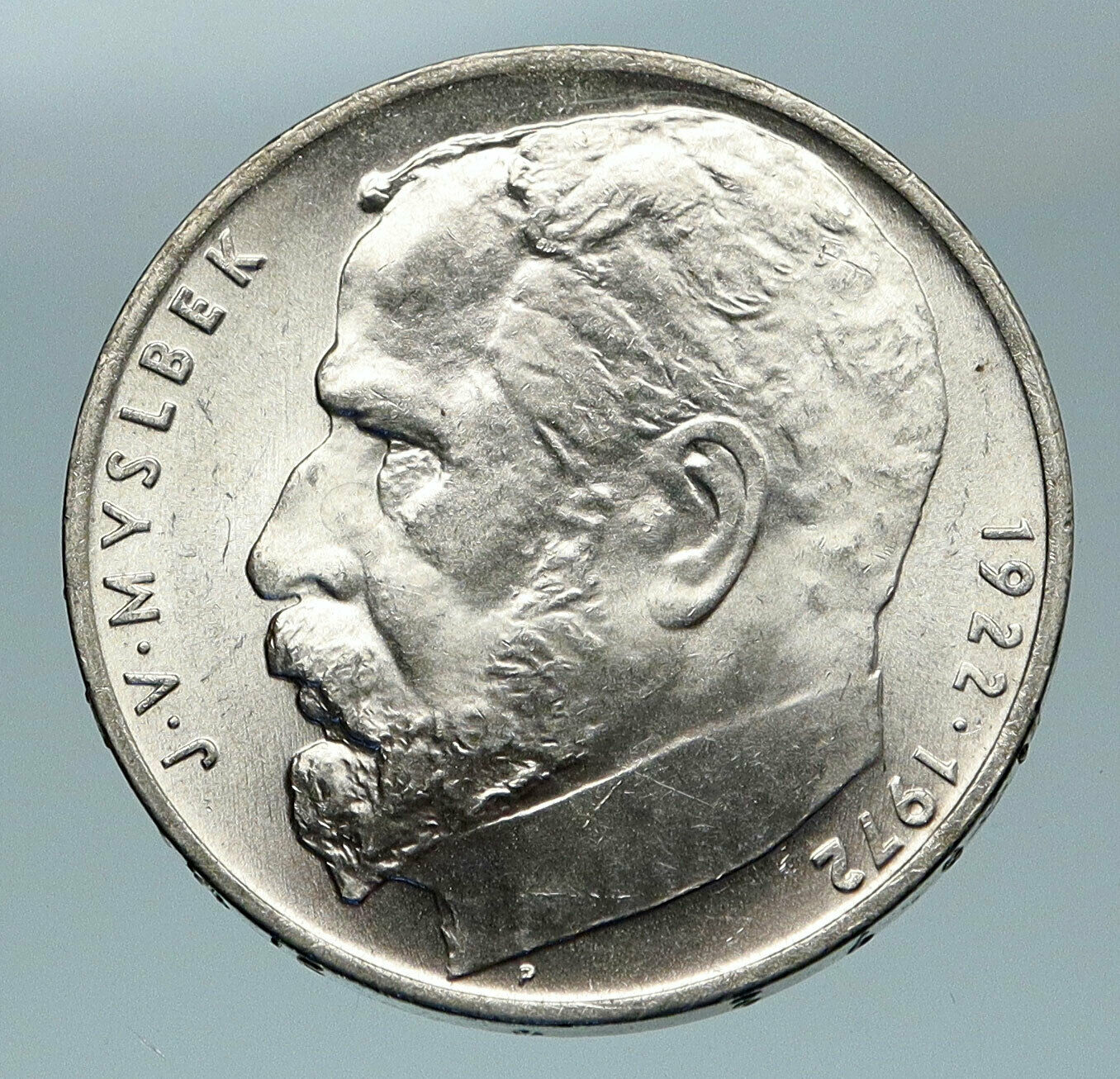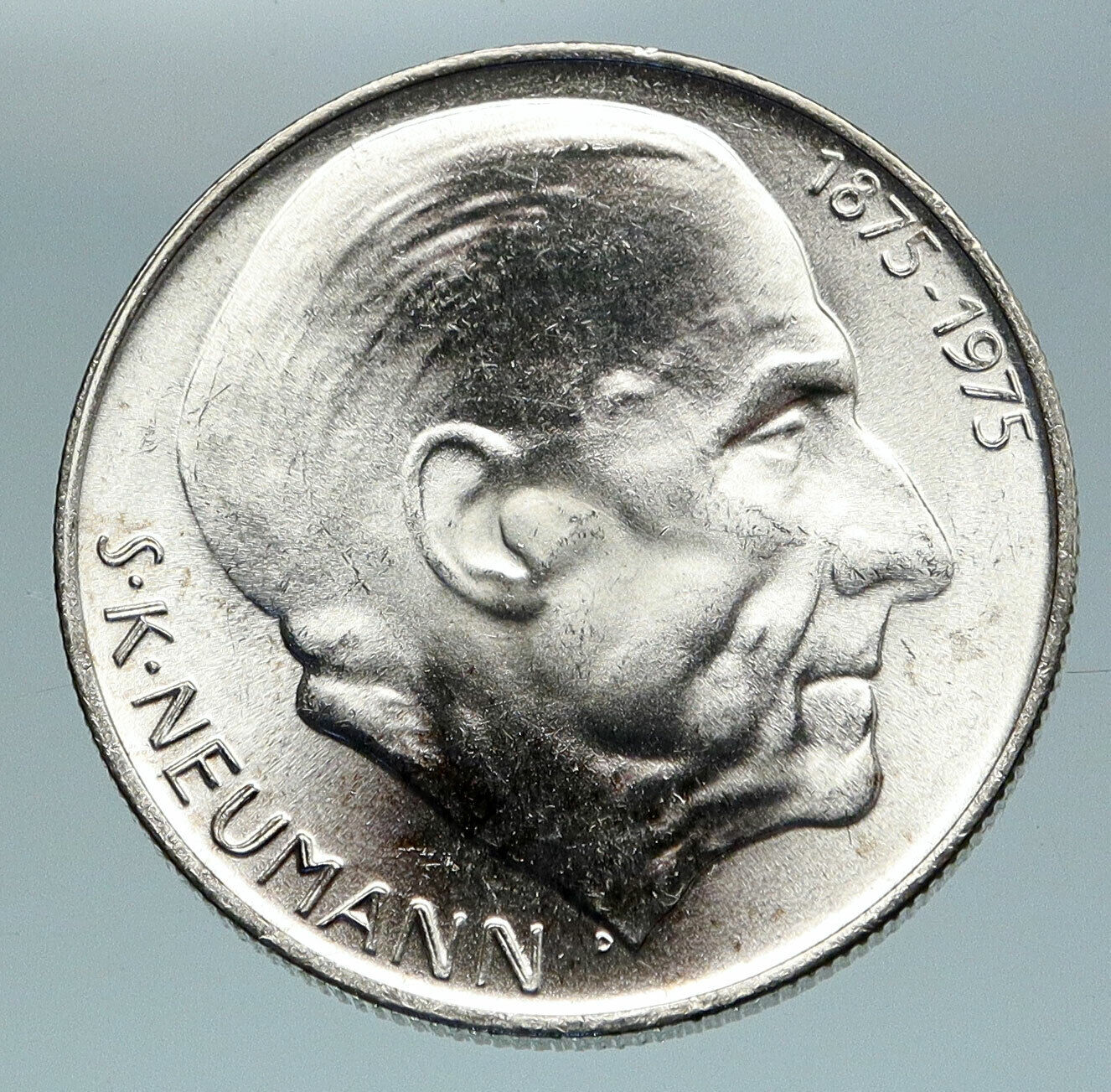|
Czech Republic – Czechoslovakia
100th Anniversary of the Death of Josef Mánes
1971 Silver 100 Korun 33mm (14.94 grams) 0.700 Silver (0.3376 oz. ASW)
Reference: KM# 73
ČESKOSLOVENSKÁ SOCIALISTICKÁ REPUBLIKA 100, Czechoslovak socialist coat-of-arms.
JOSEF MÁNES 1871 1971, Josef Mánes facing right.
Edge:
Smooth with waves and dots.
You are bidding on the exact item pictured, provided with a Certificate of Authenticity and Lifetime Guarantee of Authenticity.
 Josef Mánes (12 May 1820, Prague – 9 December 1871, Prague) was a Czech painter. He came from a family of painters, which included his father Antonín, his uncle and Director of the Prague Art Academy Václav, his brother Quido and his sister Amalie. Josef Mánes (12 May 1820, Prague – 9 December 1871, Prague) was a Czech painter. He came from a family of painters, which included his father Antonín, his uncle and Director of the Prague Art Academy Václav, his brother Quido and his sister Amalie.
His first painting lessons naturally came from his father. From 1835 to 1844, he studied at the Academy of Fine Arts, Prague, under Professors František Tkadlík and Christian Ruben. He continued his studies in Munich for two years. Upon his return, an affair with the family’s maid had unpleasant results and created an estrangement with some members of his family that left him in a state of severe depression. He found refuge in the patronage of Count Bedřich Silva-Tarouca , living and working at his castle in Průhonice for twenty years. From there, he made many trips throughout Moravia, Upper Hungary (Slovakia) and Poland.
 He took an active role in many artistic, literary and patriotic societies. He also participated in Sokol, an athletic organization for young men, designing uniforms and other materials for them. In 1857, he visited Italy and, three years later, took a trip to Russia, from which he returned mentally disturbed. He took an active role in many artistic, literary and patriotic societies. He also participated in Sokol, an athletic organization for young men, designing uniforms and other materials for them. In 1857, he visited Italy and, three years later, took a trip to Russia, from which he returned mentally disturbed.
From 1866, his mental state worsened rapidly, afflicting him with bizarre behavior and obsessions. A recuperative trip to Italy failed to improve his health and he died in 1871, after much suffering. It is believed that his brain had been affected by syphilis or meningitis.
Work and honors
 He produced many paintings in every genre from landscapes and portraits to ethnographic and botanical studies. He even did paintings of the twelve months (Calendar plate) in face of the Prague Astronomical Clock. Although his work was little understood or appreciated in his lifetime, he is now considered to be among the greatest Czech painters. He produced many paintings in every genre from landscapes and portraits to ethnographic and botanical studies. He even did paintings of the twelve months (Calendar plate) in face of the Prague Astronomical Clock. Although his work was little understood or appreciated in his lifetime, he is now considered to be among the greatest Czech painters.
In 1887, the Mánes Union of Fine Arts was created in his honor. One of the central bridges over the Vltava River bears his name and includes a statue of the painter at the Old Town end. His image has appeared on several Czechoslovak and Czech postage stamps.
 The Czech Republic also known by its short-form name, Czechia, is a landlocked country in Central Europe bordered by Germany to the west, Austria to the south, Slovakia to the east and Poland to the northeast. The Czech Republic covers an area of 78,866 square kilometres (30,450 sq mi) with a mostly temperate continental climate and oceanic climate. It is a unitary parliamentary republic, with 10.6 million inhabitants; its capital and largest city is Prague, with 1.3 million residents. Other major cities are Brno, Ostrava, Olomouc and Pilsen. The Czech Republic is a member of the European Union (EU), NATO, the OECD, the United Nations, the OSCE, and the Council of Europe. The Czech Republic also known by its short-form name, Czechia, is a landlocked country in Central Europe bordered by Germany to the west, Austria to the south, Slovakia to the east and Poland to the northeast. The Czech Republic covers an area of 78,866 square kilometres (30,450 sq mi) with a mostly temperate continental climate and oceanic climate. It is a unitary parliamentary republic, with 10.6 million inhabitants; its capital and largest city is Prague, with 1.3 million residents. Other major cities are Brno, Ostrava, Olomouc and Pilsen. The Czech Republic is a member of the European Union (EU), NATO, the OECD, the United Nations, the OSCE, and the Council of Europe.
It is a developed country with an advanced, high income export-oriented social market economy based in services, manufacturing and innovation. The UNDP ranks the country 14th in inequality-adjusted human development. The Czech Republic is a welfare state with a “continental” European social model, a universal health care system, tuition-free university education and is ranked 14th in the Human Capital Index. It ranks as the 6th safest or most peaceful country and is one of the most non-religious countries in the world, while achieving strong performance in democratic governance.
<img src="https://upload.wikimedia.org/wikipedia/commons/thumb/e/ed/Coat_of_arms_of_the_Czech_Republic.svg/85px-Coat_of_arms_of_the_Czech_Republic.svg.png" align="left" the="" czech="" republic="" includes="" historical="" territories="" of="" bohemia,="" moravia,="" and="" silesia.="" state="" was="" formed="" in="" late="" 9th="" century="" as="" duchy="" bohemia="" under="" great="" moravian="" empire.="" after="" fall="" empire="" 907,="" centre="" power="" transferred="" from="" moravia="" to="" přemyslid="" dynasty.="" 1002,="" formally="" recognized="" an="" imperial="" holy="" roman="" along="" with="" kingdom="" germany,="" burgundy,="" italy,="" numerous="" other="" territories,="" becoming="" 1198="" reaching="" its="" greatest="" territorial="" extent="" 14th="" century.="" beside="" itself,="" king="" ruled="" lands="" bohemian="" crown,="" holding="" a="" vote="" election="" emperor;="" prague="" seat="" periods="" between="" 17th="" hussite="" wars="" 15th="" driven="" by="" protestant="" reformation,="" faced="" economic="" embargoes="" defeated="" five="" consecutive="" crusades="" proclaimed="" leaders="" catholic="" church.=""
 Following the Battle of Mohács in 1526, the whole Crown of Bohemia was gradually integrated into the Habsburg Monarchy alongside the Archduchy of Austria and the Kingdom of Hungary. The Protestant Bohemian Revolt (1618-20) against the Catholic Habsburgs led to the Thirty Years’ War. After the Battle of the White Mountain, the Habsburgs consolidated their rule, eradicated Protestantism and reimposed Catholicism, and also adopted a policy of gradual Germanization. This contributed to the anti-Habsburg sentiment. A long history of resentment of the Catholic Church followed and still continues. With the dissolution of the Holy Roman Empire in 1806, the Bohemian Kingdom became part of the German Confederation 1815-1866 as part of Austrian Empire (1804 to 1867) and the Czech language experienced a revival as a consequence of widespread romantic nationalism. In the 19th century, the Czech lands became the industrial powerhouse of the monarchy and were subsequently the core of the Republic of Czechoslovakia, which was formed in 1918 following the collapse of the Austro-Hungarian Empire after World War I. Following the Battle of Mohács in 1526, the whole Crown of Bohemia was gradually integrated into the Habsburg Monarchy alongside the Archduchy of Austria and the Kingdom of Hungary. The Protestant Bohemian Revolt (1618-20) against the Catholic Habsburgs led to the Thirty Years’ War. After the Battle of the White Mountain, the Habsburgs consolidated their rule, eradicated Protestantism and reimposed Catholicism, and also adopted a policy of gradual Germanization. This contributed to the anti-Habsburg sentiment. A long history of resentment of the Catholic Church followed and still continues. With the dissolution of the Holy Roman Empire in 1806, the Bohemian Kingdom became part of the German Confederation 1815-1866 as part of Austrian Empire (1804 to 1867) and the Czech language experienced a revival as a consequence of widespread romantic nationalism. In the 19th century, the Czech lands became the industrial powerhouse of the monarchy and were subsequently the core of the Republic of Czechoslovakia, which was formed in 1918 following the collapse of the Austro-Hungarian Empire after World War I.
Czechoslovakia remained the only democracy in this part of Europe in the interwar period. However, the Czech part of Czechoslovakia was occupied by Germany in World War II, while the Slovak region became the Slovak Republic; Czechoslovakia was liberated in 1945 by the armies of the Soviet Union and the United States. Most of the three millions of the German-speaking minority were expelled following the war. The Communist Party of Czechoslovakia won the 1946 elections and after the 1948 coup d’état, Czechoslovakia became a one-party communist state under Soviet influence. In 1968, increasing dissatisfaction with the regime culminated in a reform movement known as the Prague Spring, which ended in a Soviet-led invasion. Czechoslovakia remained occupied until the 1989 Velvet Revolution, when the communist regime collapsed and market economy was reintroduced. On 1 January 1993, Czechoslovakia peacefully dissolved, with its constituent states becoming the independent states of the Czech Republic and Slovakia. The Czech Republic joined NATO in 1999 and the EU in 2004.
|





 Josef Mánes (12 May 1820, Prague – 9 December 1871, Prague) was a Czech painter. He came from a family of painters, which included his father Antonín, his uncle and Director of the Prague Art Academy Václav, his brother Quido and his sister Amalie.
Josef Mánes (12 May 1820, Prague – 9 December 1871, Prague) was a Czech painter. He came from a family of painters, which included his father Antonín, his uncle and Director of the Prague Art Academy Václav, his brother Quido and his sister Amalie.  He took an active role in many artistic, literary and patriotic societies. He also participated in Sokol, an athletic organization for young men, designing uniforms and other materials for them. In 1857, he visited Italy and, three years later, took a trip to Russia, from which he returned mentally disturbed.
He took an active role in many artistic, literary and patriotic societies. He also participated in Sokol, an athletic organization for young men, designing uniforms and other materials for them. In 1857, he visited Italy and, three years later, took a trip to Russia, from which he returned mentally disturbed.  He produced many paintings in every genre from landscapes and portraits to ethnographic and botanical studies. He even did paintings of the twelve months (Calendar plate) in face of the Prague Astronomical Clock. Although his work was little understood or appreciated in his lifetime, he is now considered to be among the greatest Czech painters.
He produced many paintings in every genre from landscapes and portraits to ethnographic and botanical studies. He even did paintings of the twelve months (Calendar plate) in face of the Prague Astronomical Clock. Although his work was little understood or appreciated in his lifetime, he is now considered to be among the greatest Czech painters.  The Czech Republic also known by its short-form name, Czechia, is a landlocked country in Central Europe bordered by Germany to the west, Austria to the south, Slovakia to the east and Poland to the northeast. The Czech Republic covers an area of 78,866 square kilometres (30,450 sq mi) with a mostly temperate continental climate and oceanic climate. It is a unitary parliamentary republic, with 10.6 million inhabitants; its capital and largest city is Prague, with 1.3 million residents. Other major cities are Brno, Ostrava, Olomouc and Pilsen. The Czech Republic is a member of the European Union (EU), NATO, the OECD, the United Nations, the OSCE, and the Council of Europe.
The Czech Republic also known by its short-form name, Czechia, is a landlocked country in Central Europe bordered by Germany to the west, Austria to the south, Slovakia to the east and Poland to the northeast. The Czech Republic covers an area of 78,866 square kilometres (30,450 sq mi) with a mostly temperate continental climate and oceanic climate. It is a unitary parliamentary republic, with 10.6 million inhabitants; its capital and largest city is Prague, with 1.3 million residents. Other major cities are Brno, Ostrava, Olomouc and Pilsen. The Czech Republic is a member of the European Union (EU), NATO, the OECD, the United Nations, the OSCE, and the Council of Europe.  Following the Battle of Mohács in 1526, the whole Crown of Bohemia was gradually integrated into the Habsburg Monarchy alongside the Archduchy of Austria and the Kingdom of Hungary. The Protestant Bohemian Revolt (1618-20) against the Catholic Habsburgs led to the Thirty Years’ War. After the Battle of the White Mountain, the Habsburgs consolidated their rule, eradicated Protestantism and reimposed Catholicism, and also adopted a policy of gradual Germanization. This contributed to the anti-Habsburg sentiment. A long history of resentment of the Catholic Church followed and still continues. With the dissolution of the Holy Roman Empire in 1806, the Bohemian Kingdom became part of the German Confederation 1815-1866 as part of Austrian Empire (1804 to 1867) and the Czech language experienced a revival as a consequence of widespread romantic nationalism. In the 19th century, the Czech lands became the industrial powerhouse of the monarchy and were subsequently the core of the Republic of Czechoslovakia, which was formed in 1918 following the collapse of the Austro-Hungarian Empire after World War I.
Following the Battle of Mohács in 1526, the whole Crown of Bohemia was gradually integrated into the Habsburg Monarchy alongside the Archduchy of Austria and the Kingdom of Hungary. The Protestant Bohemian Revolt (1618-20) against the Catholic Habsburgs led to the Thirty Years’ War. After the Battle of the White Mountain, the Habsburgs consolidated their rule, eradicated Protestantism and reimposed Catholicism, and also adopted a policy of gradual Germanization. This contributed to the anti-Habsburg sentiment. A long history of resentment of the Catholic Church followed and still continues. With the dissolution of the Holy Roman Empire in 1806, the Bohemian Kingdom became part of the German Confederation 1815-1866 as part of Austrian Empire (1804 to 1867) and the Czech language experienced a revival as a consequence of widespread romantic nationalism. In the 19th century, the Czech lands became the industrial powerhouse of the monarchy and were subsequently the core of the Republic of Czechoslovakia, which was formed in 1918 following the collapse of the Austro-Hungarian Empire after World War I. 




